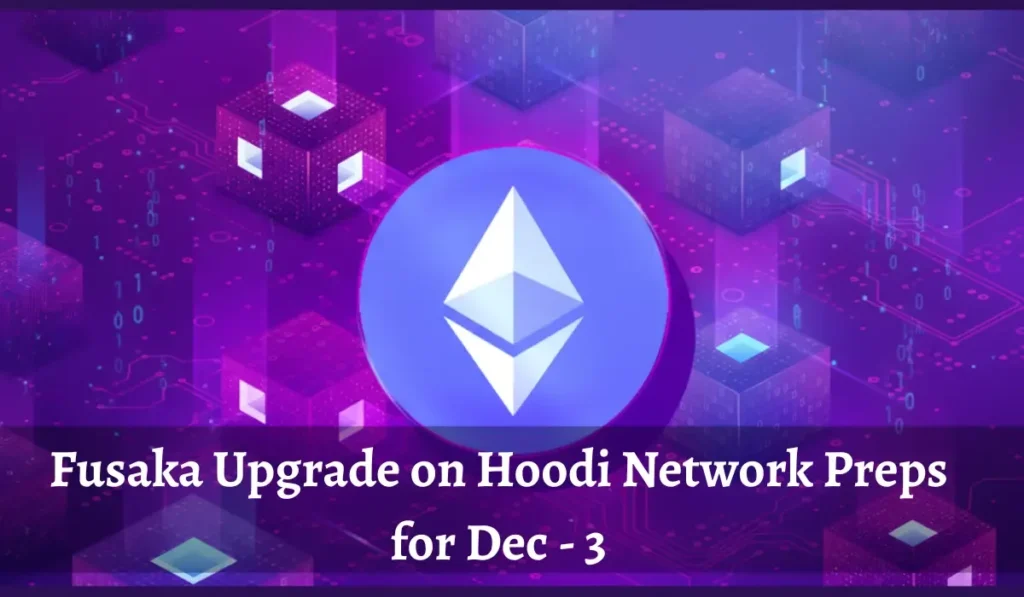Fusaka Upgrade on Hoodi Network Preps for Dec Mainnet

Key Takeaways
- Fusaka upgrade on Hoodi Testnet launched successfully on Tuesday, 28th October 2025.
- Testing for bugs and interoperability problems has begun.
- This testing phase will help fine-tune the upgrade before integrating it into the mainnet.
- After three successful testnet launches, Ethereum is scheduled to roll out the Fusaka Upgrade by December 3rd, 2025.
With three successful testnet runs completed with the final one on Hoodi launched on 28th October 2025, Ethereum is on the way to roll out its Fusaka upgrade by December 3rd of this year(2025).
Since Ethereum’s long-term development goals and commitment are towards building and maintaining a sustainable and scalable network, this achievement remains a significant milestone.
About The Fusaka Upgrade on Hoodi Testnet Launch Event
The Fusaka upgrade on the Hoodi testnet was launched around 18:53 UTC on 28th October, 2025. This launch is aimed at fault-proofing the main event, that is, the Fusaka upgrade mainnet launch scheduled on December 3rd, 2025.
The Hoodi testnet was launched during the earlier part of 2025. This testnet closely replicates Ethereum’s mainnet. The testnets are used for checking if there are any issues with the network when it undergoes major changes.
After successful testing of the Fusaka upgrade on Sepolia and Holesky, the testing of the upgrade on the final testnet stage, Hoodi, is a milestone for Ethereum’s latest Fusaka upgrade.
With this testnet launched successfully with the upgrade, it has set the road to rolling out the mainnet on its right schedule.
What is The Fusaka Upgrade?
The Fusaka upgrade is the latest of several iterations of Ethereum’s continuous development of its network structure. This upgrade is expected to remove the bottlenecks on the blockchain by increasing the transaction size.
This largely improves the performance and scalability of the network. By migrating from the traditional Merkle tree cryptographic data structure, Fusaka aims to lower the data size for validators. This will also reduce the computational loads. Fusaka aims to do so by making use of the Verkle tree in place of a Merkle tree.
This migration is expected to boost Ethereum’s performance and resilience. The adaptation of the Verkle tree will reduce storage requirements without compromising on speed and transaction volumes. The adaptation is part of Ethereum’s scalability and decentralization roadmap.
The Importance of Testing Fusaka on The Hoodi Testnet
The Hoodi testnet is the one that most closely mirrors the mainnet when compared to Sepolia and Holesky. The Hoodi testnet includes certain key features and functions that are integral parts of the mainnet. This includes factors and parameters like validator behaviour, staking infrastructure, client diversity, state size, and network traffic.
Since the Hoodi network closely mirrors the actual mainnet, testing the strength of the mainnet after integration of the upgrade can be done here. This includes final bug and interoperability checks. Ethereum introduces EIPs (Ethereum Improvement Proposals) along with each upgrade. These EIPs must comply with the network consensus and governance. A great way to test this is via a testnet that mirrors the mainnet closely.
Since the Fusaka upgrade is aimed at improving the mainnet’s scalability and performance, a direct adaptation might create problems with tuning. On the other hand, by prior launch on the Hoodi network that closely mirrors the mainnet, developers can fine-tune the parameters according to the load requirements. This level of fault-proofing freedom ensures that the final rollout does not have any problems.
Testing the ecosystem readiness is another aspect of running the upgrade on the Hoodi testnet. Several components work together to make the Ethereum network more user-friendly. Some of these components are wallets, explorer services, staking providers, rollups, layer-2 applications, etc. These services need to run smoothly after the upgrade, so the testnet launch of Fusaka looks for any problems that arise because of the launch. Then it will mitigate them so that the final mainnet run is a smooth process without any hiccups.
Final Words
The checks and tests for the Fusaka upgrade over the mainnet are an essential part of the upgrade launch process. Since multiple stakeholders are relying on the mainnet, it is very important to check for possible problems that may cause a major breakdown of services.
In short, by testing the upgrade by integrating it on the Hoodi testnet, developers will be able to closely monitor how the most recent upgrade performs. This is a vital step in Ethereum’s mission to create continuous development throughout its life cycle.
These upgrades greatly increase the performance of the network, thereby facilitating users with a much more user-friendly system with high scalability and resilience.
Also Read: Ethereum Price Prediction
Crypto & Blockchain Expert
